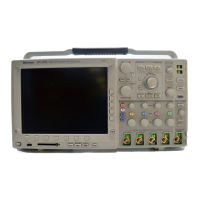Dependencies. In general, math waveforms that include sources as operands are affected by updates to those sources:
■
Shifts in amplitude or DC level of input sources that cause the source to clip also clip the waveform data supplied to the
math waveform.
■
Changes to the vertical offset setting for a channel source that clip its data also clip the waveform data supplied to the math
waveform.
■
Changes to the acquisition mode globally affects all input channel sources, modifying any math waveforms using them. For
example, with the acquisition mode set to Envelope, a Ch1 + Ch2 math waveform will receive enveloped channel 1 and
channel 2 data, and will also be an envelope waveform.
■
Clearing the data in a waveform source causes a baseline (ground) to be delivered to any math waveform that includes that
source until the source receives new data.
What do you want to do next?
Learn about math waveform expression syntax.
Go to a step-by-step procedure for creating math waveforms.
Go to a step-by step procedure for using math waveforms.
Math waveform expression syntax
You can build math waveforms using the Predefined Expressions or Equation Editor control window. To help you create valid
math waveforms, the following tools will block most illegal entries by disabling any window element that would create an invalid
entry in the math waveform expression.
Predefined expressions are performed from the Math Setup control window by selecting an expression.
The following syntax describes the valid math expressions you can use with the Equation Editor:
<MathWaveform> := <Expression>
<Expression> := <UnaryExpression> | <BinaryExpression>
<UnaryExpression> := <UnaryOperator> ( <Term>) | <UnaryOperator> ( <Expression>)
<BinaryExpression> := <Term> <BinaryOperator> <Term> | <Scalar>
<BinaryOperator> <Term> | <Term> <BinaryOperator> <Scalar>
<Term> := <Waveform> | ( <Expression>)
<Scalar> := <Integer> | <Float> | <Meas-Result>
<Waveform> := <ChannelWaveform> | <ReferenceWaveform> | <MathWaveform>
<ChannelWaveform> := Ch1 | Ch2 | Ch3 | Ch4
<ReferenceWaveform> := Ref1 | Ref2 | Ref3 | Ref4
<MathWaveform> := Math1 | Math2 | Math3 | Math4
<UnaryOperator> := Invert | Derivative | Integral | Average | Max | Min | Filter |
Vmag | Exp | log 10 | log e | sqrt | Spectral Magnitude| Spectral Phase | Spectral
Real | Spectral Imag
<BinaryOperator> := + | - | / | *
<Meas-Result> := meas1 | meas2 | meas3 | meas4 | meas5 | meas6 | meas7 | meas8
What do you want to do next?
Learn about math waveform differentiation.
Oscilloscope reference
706 DPO70000SX, MSO/DPO70000DX, MSO/DPO70000C, DPO7000C, and MSO/DPO5000B Series

